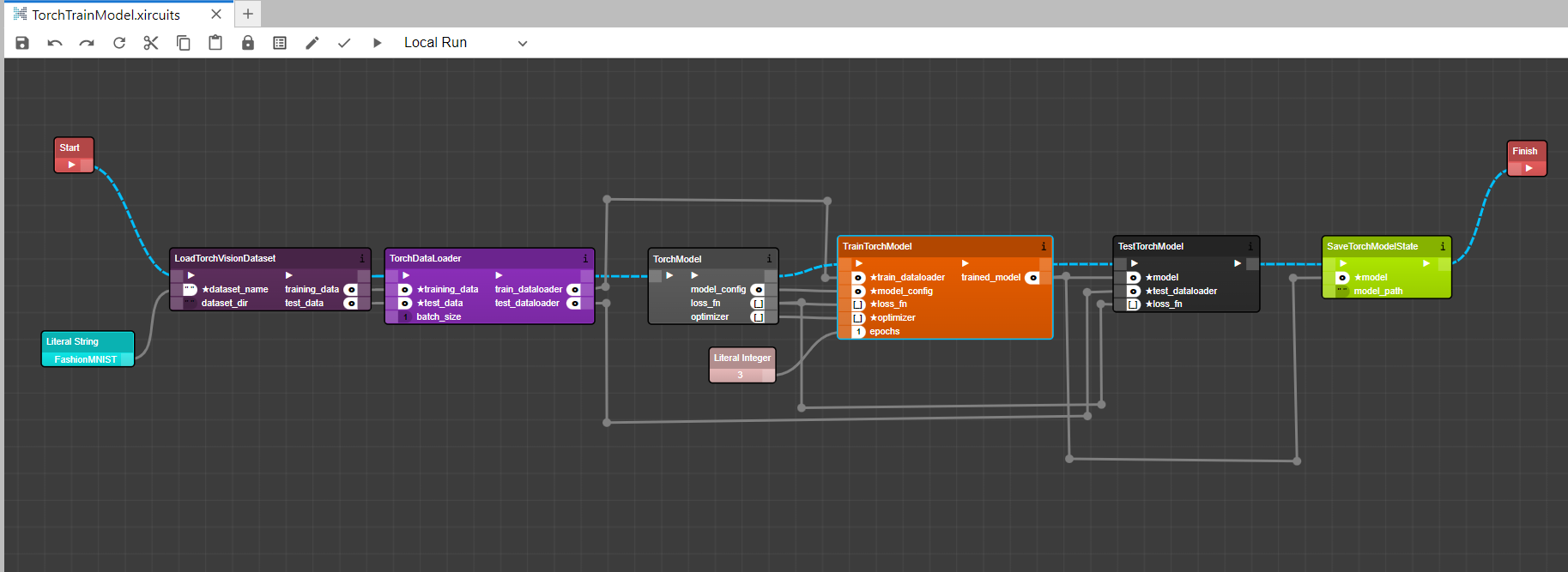Pytorch
Before running this example, ensure that you have already installed the Pytorch component library. You can do this by:
xircuits install pytorch
Training a Torch ML Model
The following example showcases how to load a Torch dataset, specify a Torch model, train and evaluate, then save the state in Xircuits.

Example: TorchTrainModel.xircuits
LoadTorchVisionDataset: Loads a Torch Vision Dataset. For this case, we're loading the FashionMNIST dataset.TorchDataLoader: Creates an iterator for the dataset. The batch size can be adjusted depending on your device memory. By default the size is 64.TorchModel: A custom PyTorch neural network model that expects a 28*28 input. Internally it is defined as:class NeuralNetwork(nn.Module):
def __init__(self):
super(NeuralNetwork, self).__init__()
self.flatten = nn.Flatten()
self.linear_relu_stack = nn.Sequential(
nn.Linear(28*28, 512),
nn.ReLU(),
nn.Linear(512, 512),
nn.ReLU(),
nn.Linear(512, 10)
)
def forward(self, x):
x = self.flatten(x)
logits = self.linear_relu_stack(x)
return logitsYou may modify the model definition by opening the script via right click menu. Additionally, you can also experiment on changing the loss function and optimizers which are passed to the
TrainTorchModelcomponent. By default they are using CrossEntropyLoss and SGD with learning rate of 1e-3.TrainTorchModel: Trains a Torch model given a Torch neural network config as well as a data iterator fromTorchDataLoader. Epochs are configurable.TestTorchModel: Tests a trained Torch model instance against data provided fromTorchDataLoader.SaveTorchModelState: Saves the trained Torch model into a state dict.pth. If the path is not provided, the model will be saved under the same name as the Xircuits canvas.
Expected Output
======================================
__ __ ___ _ _
\ \ \ \/ (_)_ __ ___ _ _(_) |_ ___
\ \ \ /| | '__/ __| | | | | __/ __|
/ / / \| | | | (__| |_| | | |_\__ \
/_/ /_/\_\_|_| \___|\__,_|_|\__|___/
======================================
Xircuits is running...
Executing: LoadTorchVisionDataset
Downloading FashionMNIST to data
Executing: TorchDataLoader
Shape of X [N, C, H, W]: torch.Size([64, 1, 28, 28])
Shape of y: torch.Size([64]) torch.int64
Executing: TorchModel
Using cpu device
NeuralNetwork(
(flatten): Flatten(start_dim=1, end_dim=-1)
(linear_relu_stack): Sequential(
(0): Linear(in_features=784, out_features=512, bias=True)
(1): ReLU()
(2): Linear(in_features=512, out_features=512, bias=True)
(3): ReLU()
(4): Linear(in_features=512, out_features=10, bias=True)
)
)
Executing: TrainTorchModel
Using cpu device
Epoch 1
-------------------------------
loss: 2.298100 [ 0/60000]
loss: 2.294125 [ 6400/60000]
loss: 2.274020 [12800/60000]
loss: 2.263388 [19200/60000]
loss: 2.250272 [25600/60000]
loss: 2.205179 [32000/60000]
loss: 2.225069 [38400/60000]
loss: 2.186872 [44800/60000]
loss: 2.180459 [51200/60000]
loss: 2.145460 [57600/60000]
Epoch 2
-------------------------------
loss: 2.157059 [ 0/60000]
loss: 2.150169 [ 6400/60000]
loss: 2.091775 [12800/60000]
loss: 2.104574 [19200/60000]
loss: 2.052130 [25600/60000]
loss: 1.982857 [32000/60000]
loss: 2.017010 [38400/60000]
loss: 1.938391 [44800/60000]
loss: 1.943105 [51200/60000]
loss: 1.860412 [57600/60000]
Epoch 3
-------------------------------
loss: 1.902195 [ 0/60000]
loss: 1.868288 [ 6400/60000]
loss: 1.757673 [12800/60000]
loss: 1.796579 [19200/60000]
loss: 1.678521 [25600/60000]
loss: 1.632160 [32000/60000]
loss: 1.656519 [38400/60000]
loss: 1.565977 [44800/60000]
loss: 1.594191 [51200/60000]
loss: 1.476008 [57600/60000]
Executing: TestTorchModel
Using cpu device
Test Error:
Accuracy: 63.3%, Avg loss: 1.502265
Executing: SaveTorchModelState
Saved PyTorch Model State to examples/TorchTrainModel.pth
Finish Executing
Performing Inference using Torch
The following example showcases how to load a Torch model state and perform an inference.

To perform inference, you will need the following components:
Image2TorchTensor: converts an image loaded from provided path to a Torch tensor.TorchModel: creates a custom Torch model config. Ensure that you have used the same model config used in training.LoadTorchModelState: loads a Torch model state from a previously saved .pth. You will also need to provide the original Torch model class, in this case the previousTorchModel.TorchModelPredictFromTensor: loads performs a prediction given a Torch model configuration, tensor, and class list. For this example, we have trained using the FashionMNIST dataset, and therefore the classes are"T-shirt/top", "Trouser", "Pullover", "Dress", "Coat", "Sandal", "Shirt", "Sneaker", "Bag", "Ankle boot".
Expected Output
======================================
__ __ ___ _ _
\ \ \ \/ (_)_ __ ___ _ _(_) |_ ___
\ \ \ /| | '__/ __| | | | | __/ __|
/ / / \| | | | (__| |_| | | |_\__ \
/_/ /_/\_\_|_| \___|\__,_|_|\__|___/
======================================
Xircuits is running...
Executing: Image2TorchTensor
Size of the Original image: (11667, 13610)
Size of the image after resize: (28, 28)
Size of the tensor: torch.Size([1, 28, 28])
Executing: TorchModel
Using cpu device
NeuralNetwork(
(flatten): Flatten(start_dim=1, end_dim=-1)
(linear_relu_stack): Sequential(
(0): Linear(in_features=784, out_features=512, bias=True)
(1): ReLU()
(2): Linear(in_features=512, out_features=512, bias=True)
(3): ReLU()
(4): Linear(in_features=512, out_features=10, bias=True)
)
)
Executing: LoadTorchModelState
Using cpu device
Executing: TorchModelPredictFromTensor
Using cpu device
Predicted: "Shirt"
Finish Executing